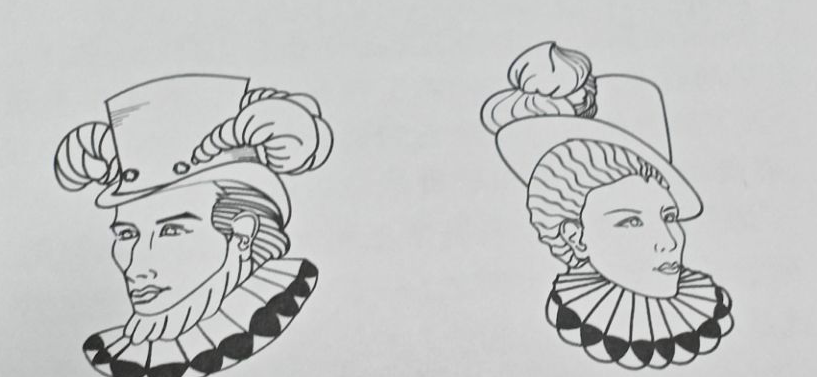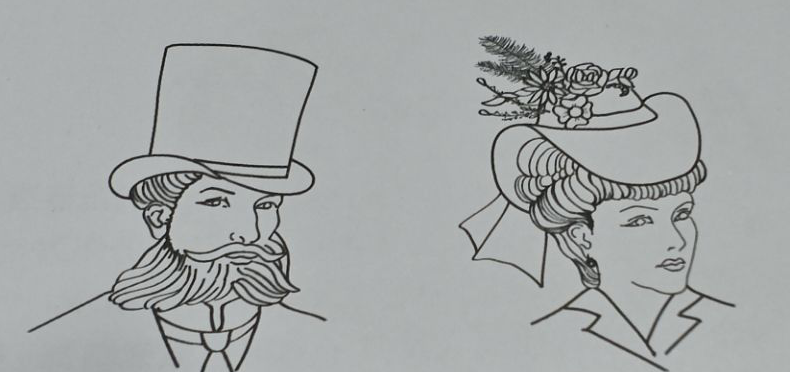Hat Design and Expression – Aung Crown: The Brief Hat History in Western
Published On: November 27, 2023 By: kailyn

The development of hats has a long and distinguished history, and the design of hats is fantastic in every description. Hats as a special gain for humans, it’s both the result of material civilization, also a feature of spiritual civilization. It’s instinctive to pursue beauty. Clothing for humans is just like the golden layer for Buddha. The function of clothing is not only to cover the body and keep warm but also with the function of beautifying. Since hats were first produced, the design of hats has been full of human costumes, appreciation for beauty, hobbies of colors, and even cultural attitudes and religious views.
A Brief Hat History in Western
Hats were designed to keep warm or provide sun protection. However, with the development of human civilization, hats had become a trendy stream, also as a state symbolization, particularly in duchesses. Those ladies were addicted to pursuing and loving hats.
Middle Ages
Hats as a decorative accessory, existed in ancient times. Hats can protect heads and have lots of meanings at the same time. In ancient times, people didn’t have the ability to make exquisite hats and they wrapped cloth around their heads. This design was similar to the turban today, which was a piece of cloth. As for hairstyles, it was casual or loose hair or made a hair bundle. After coming into the middle ages, Holy See pushed the regulation that people needed to cover their hair. Therefore, there came out many simple and sincere hat types.

The 17th Century
In the 17th century, hats had a hierarchy meaning obviously, namely, dark color hats for citizens, yellow hats for bankruptcy men, and paper hats for criminals. The golden crown or hat for the king. With the development of knight uniforms, men’s hats were gradually becoming high-crown and narrow-brim styles. Women’s hats were close to men’s hats at that time.

The 18th Century
During the 18th century, hats were extremely luxurious. Besides loving the top hats, the loyal class pursued braided and wig (big hairstyle). According to the professional braid hair workers, based on the owner’s needs, the workers needed to make a hair ladder first, then followed the hair ladder to braid down. After finishing braiding, the workers could add the hat part with some ornaments on.
At that time, hair was regarded as a personal privacy part, it must be covered with hats. Even at home, it also needed to make a decent hair bundle and could not be loose down casually. Therefore, the best way to cover hair was by wearing infinitely exaggerated hats. The loose, expanding, colorful, and easy hat style made feathers one of the best choices for hat ornaments at that time. Different textural feathers could be made in different hat styles. It was a very common way to match a hairnet and it’s also one of the fashionable styles that dames pursued.
Men wore triangular hats or two-horn hats. These hats originated in the military, then they were famous in the courts, and later popular among Europe, being one part of military and daily dressing.

The 19th Century
In 1840, hats started to be slightly curved in dramas. The size of hats occasionally started to become reserved. This period was the reformation time for hat styles. Until now, the outer look of hats has focused on functions and mobility. Only in the horse racing game of the noble in the United Kingdom, there will be some exaggerated hats occasionally.

In the 20th Century
In 1917, cloche hats came out. The brim of cloche hats was designed to cover one eye of the wear, which was popular at that time, until 1920. The statement about fashion starting from eyebrow originated from this. This type of brim in cloche hat was invented by Caroline Loeb, the French designer. If a woman didn’t want to cut her long hair, then a cloche hat could make the long hair become fashionable short hair. This kind of style was the most vintage and elegant, leading to the Bobo hairstyle – a new hairstyle that was popular at that time. Because this bobo hairstyle matched a cloche hat, which could make the wearer cute, trendy, and elegant at the same time.
In the 1930s
In the 1930s, surrealist fashion was popular, then surrealism and hats tangled with each other. The result of this was that exaggerated hats were popular, including women’s turbans, triangular hats, Couple-Vent hats, and even shoe kickbacks on the top of hats. Due to the return of feminine styles, the style of female clothing became long, and the line was more gentle to emphasize the breast, waist, and hipline. Hats started to become small which would not be low to press the ears. Instead, it was inclined to one side elegantly.
During The Second World War
During the Second World War, due to the shortage of supplies, people were busy in war or handling life. At this time, women were restricted by the time, even the noble, most people chose elegant coiffure. It was not picky about hats, then hats started to become the original style. Therefore, the celebrity and influence of cloche hats gained their highest peak at that time. Then, brimless hats and beret caps were changed with men’s outfits after the war and were popular at that time.
After the Second World War
After the Second World War, manufacturers were getting into the golden period. People got tired of wars, uniforms, and the female portrait that was strong as a boxer, and looked forward to the elegant and gentle portrait of women. In 1947, Dior published the “new look”, which people were surprised by it. “New Look” – wide-brim top hats and puff-skirt dresses recalled people’s great memory of the beauties of peaceful times. The coming of the “new look” made wide-brim hats and flat-top hard hats popular again. The materials for hat-making became more and more. However, because of the recession in the utility of hats, hats were quickly becoming a decorative accessory for formal or indeed occasions. The hegemony state of hats in the past was gone and only a few royal people had s preference for hats, liking the Queen of the United Kingdom and the princess.
The Dilemma for Hats
The dilemma for hats had been released by Jacqueline Kennedy. Jacqueline Kennedy, the most charming First Lady in American history evoked people by wearing a brimless, flat-top, and small pillbox hat public. Women also realized that it was time to update hats. At the same time, under the leadership of the new generation pioneers – Gabrielle Chanel and Paul Pole, people started to pursue simple and elegant looks. Soon after, there was a honeycomb hairstyle in the fashion industry. In order to not destroy this hairstyle, designers ingeniously designed a hat that was close to cylindrical and named a pillbox. The design of the pillbox was ingenious and could complement hair. What’s more, didn’t need to take off and would not ruin the hairstyle, which was elegant and simple. Therefore, pillbox became the favorite hat in the 1950s.
Nowadays
With the development of Western hats today, western hats are a must-have accessory for people’s daily wearing or to show their own personalities. Unique-style hats are more popular among celebrities. Many hat designers are merging. Not only like Philip Tracy, is a famous hat artist, but also there are many new and novel hat designers who are shining in the fashion industry.
In the end, all the history above is collected by Aung Crown. Aung Crown is a professional hat maker founded in 1998 with more than 25 years of experience and expertise in hat making and hats. In addition, we will share more articles about hats. If you’re interested in it, please save our website to your favorite.
